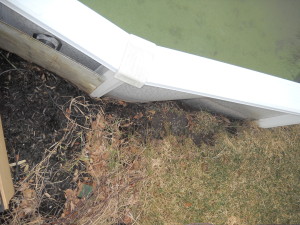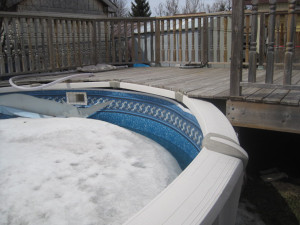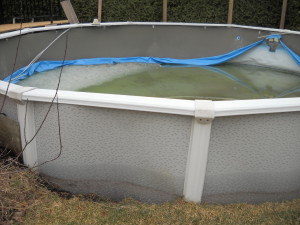Avoid backfilling and decorative rocks

Although various installers have different views on backfilling above-ground pools, this installation approach should generally be avoided. While some homeowners like the look of a backfilled pool, there are several reasons why this can be problematic.
In some cases, backfilling an above-ground pool can put too much pressure on the structure, which can damage the pool or even cause it to collapse. And, in some cases, it can also make the pool liner difficult to replace. Further, during the winter, water will collect around the outside perimeter of a backfilled pool when instead it should drain away from this area.
In terms of a pool owner protecting his/her investment, an above-ground pool, which has been backfilled will, in some cases, void the manufacturer’s warranty as well as any insurance claims.
Decorative rocks or stonework installed around the perimeter of an above-ground pool can also cause drainage issues. Although these features are esthetically pleasing and can prevent weeds from growing around the pool, they are better suited for warmer climates. With the harsh winters experienced in this region, the rain in the fall accumulates under and around these rocks/stones. Once this water freezes, it can damage the bottom track of the pool as it will lock the track to the ground and, when the frost shifts, the pool will move with it causing severe damage. The pool structure can be likened to the foundation of a house; water should be encouraged to flow away from the pool, not gather around it.
Decks in relation to above-ground pools
A homeowner planning where their above-ground pool will be installed in relation to their deck is critical. For instance, there have been many cases where a simple deck has made the difference in a perfectly installed above-ground pool lasting several years or only a single season.

Again, due to the harsh winter climate in some regions of Canada, the pool should not have any contact with the deck. The desire of many homeowners to eliminate these gaps (between the pool and deck) has seen many above-ground pools fall victim to shifting decks.
Above-ground pools should be installed no closer than 76 m (3 in.) to a deck and only experienced contract deck builders should build them when in proximity to these pools.

Should an installer not follow these best practices, and the pool and deck are touching, when the ground begins to shift, the pool will ultimately lose the battle. The deck should not overhang the pool’s top rail, either. Almost every spring, above-ground pool installers receive photos of damaged pools from baffled homeowners where in most cases the deck is determined to be the culprit. This is easily determined by looking at the opposite end of the pool structure for signs of buckling.
Therefore, during the winterization process, the homeowner needs to ensure anything that is overhanging the deck, e.g. ladder or steps, is removed. When the ground shifts, there should be no contact between any part of the deck and pool. This will save the pool owner a lot of grief come spring.







I am interested to buy an on ground pool (smallest size) kidney or key shape…60 inch flat bottom for a new construction.
Please send me your best price for pool and installation…no accessories such a heatpump or salt system…basic need for a tight budget.
Thanks.